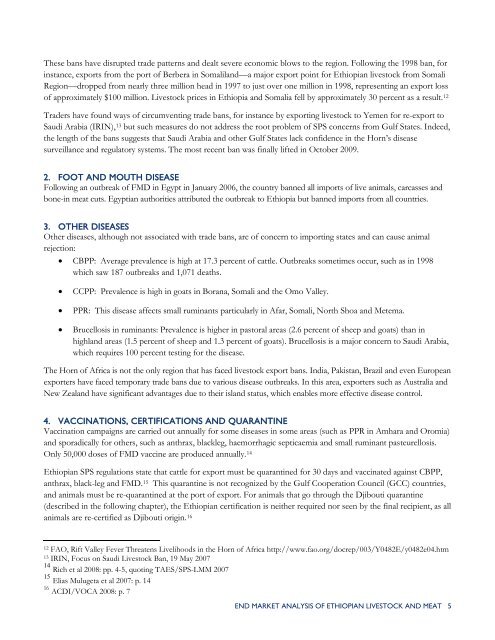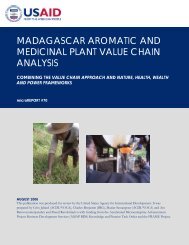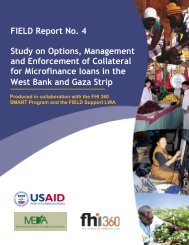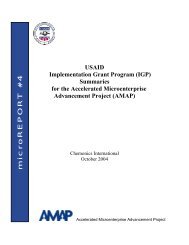End Market Analysis of Ethiopian Livestock and ... - USAID Microlinks
End Market Analysis of Ethiopian Livestock and ... - USAID Microlinks
End Market Analysis of Ethiopian Livestock and ... - USAID Microlinks
You also want an ePaper? Increase the reach of your titles
YUMPU automatically turns print PDFs into web optimized ePapers that Google loves.
These bans have disrupted trade patterns <strong>and</strong> dealt severe economic blows to the region. Following the 1998 ban, for<br />
instance, exports from the port <strong>of</strong> Berbera in Somalil<strong>and</strong>—a major export point for <strong>Ethiopian</strong> livestock from Somali<br />
Region—dropped from nearly three million head in 1997 to just over one million in 1998, representing an export loss<br />
<strong>of</strong> approximately $100 million. <strong>Livestock</strong> prices in Ethiopia <strong>and</strong> Somalia fell by approximately 30 percent as a result. 12<br />
Traders have found ways <strong>of</strong> circumventing trade bans, for instance by exporting livestock to Yemen for re-export to<br />
Saudi Arabia (IRIN), 13 but such measures do not address the root problem <strong>of</strong> SPS concerns from Gulf States. Indeed,<br />
the length <strong>of</strong> the bans suggests that Saudi Arabia <strong>and</strong> other Gulf States lack confidence in the Horn’s disease<br />
surveillance <strong>and</strong> regulatory systems. The most recent ban was finally lifted in October 2009.<br />
2. FOOT AND MOUTH DISEASE<br />
Following an outbreak <strong>of</strong> FMD in Egypt in January 2006, the country banned all imports <strong>of</strong> live animals, carcasses <strong>and</strong><br />
bone-in meat cuts. Egyptian authorities attributed the outbreak to Ethiopia but banned imports from all countries.<br />
3. OTHER DISEASES<br />
Other diseases, although not associated with trade bans, are <strong>of</strong> concern to importing states <strong>and</strong> can cause animal<br />
rejection:<br />
• CBPP: Average prevalence is high at 17.3 percent <strong>of</strong> cattle. Outbreaks sometimes occur, such as in 1998<br />
which saw 187 outbreaks <strong>and</strong> 1,071 deaths.<br />
• CCPP: Prevalence is high in goats in Borana, Somali <strong>and</strong> the Omo Valley.<br />
• PPR: This disease affects small ruminants particularly in Afar, Somali, North Shoa <strong>and</strong> Metema.<br />
• Brucellosis in ruminants: Prevalence is higher in pastoral areas (2.6 percent <strong>of</strong> sheep <strong>and</strong> goats) than in<br />
highl<strong>and</strong> areas (1.5 percent <strong>of</strong> sheep <strong>and</strong> 1.3 percent <strong>of</strong> goats). Brucellosis is a major concern to Saudi Arabia,<br />
which requires 100 percent testing for the disease.<br />
The Horn <strong>of</strong> Africa is not the only region that has faced livestock export bans. India, Pakistan, Brazil <strong>and</strong> even European<br />
exporters have faced temporary trade bans due to various disease outbreaks. In this area, exporters such as Australia <strong>and</strong><br />
New Zeal<strong>and</strong> have significant advantages due to their isl<strong>and</strong> status, which enables more effective disease control.<br />
4. VACCINATIONS, CERTIFICATIONS AND QUARANTINE<br />
Vaccination campaigns are carried out annually for some diseases in some areas (such as PPR in Amhara <strong>and</strong> Oromia)<br />
<strong>and</strong> sporadically for others, such as anthrax, blackleg, haemorrhagic septicaemia <strong>and</strong> small ruminant pasteurellosis.<br />
Only 50,000 doses <strong>of</strong> FMD vaccine are produced annually. 14<br />
<strong>Ethiopian</strong> SPS regulations state that cattle for export must be quarantined for 30 days <strong>and</strong> vaccinated against CBPP,<br />
anthrax, black-leg <strong>and</strong> FMD. 15 This quarantine is not recognized by the Gulf Cooperation Council (GCC) countries,<br />
<strong>and</strong> animals must be re-quarantined at the port <strong>of</strong> export. For animals that go through the Djibouti quarantine<br />
(described in the following chapter), the <strong>Ethiopian</strong> certification is neither required nor seen by the final recipient, as all<br />
animals are re-certified as Djibouti origin. 16<br />
12 FAO, Rift Valley Fever Threatens Livelihoods in the Horn <strong>of</strong> Africa http://www.fao.org/docrep/003/Y0482E/y0482e04.htm<br />
13 IRIN, Focus on Saudi <strong>Livestock</strong> Ban, 19 May 2007<br />
14<br />
Rich et al 2008: pp. 4-5, quoting TAES/SPS-LMM 2007<br />
15<br />
Elias Mulugeta et al 2007: p. 14<br />
16<br />
ACDI/VOCA 2008: p. 7<br />
END MARKET ANALYSIS OF ETHIOPIAN LIVESTOCK AND MEAT 5





